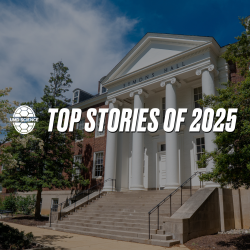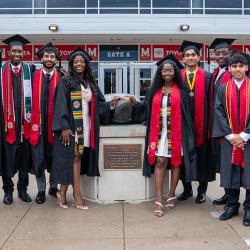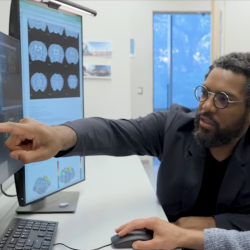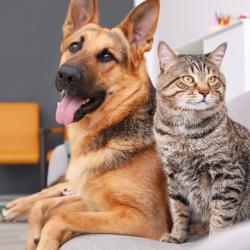Flippers, Fins and Terrapins
How Claire Bolster’s (B.S. ’20, biological sciences) fascination with biology, marine animals and ecosystems launched her dream career in marine science at Mystic Aquarium.
Claire Bolster (B.S. ’20, biological sciences) has dedicated her career to the care and rehabilitation of marine animals, whether they have flippers, feathers or fins.
“One of the coolest things about my work is just being an integral part of an animal's life and making their life better every day,” Bolster explained. “One of my old bosses told me a long time ago that our quality of work is their quality of life, and that's something that has literally been branded into my brain, and it frames everything I do.”
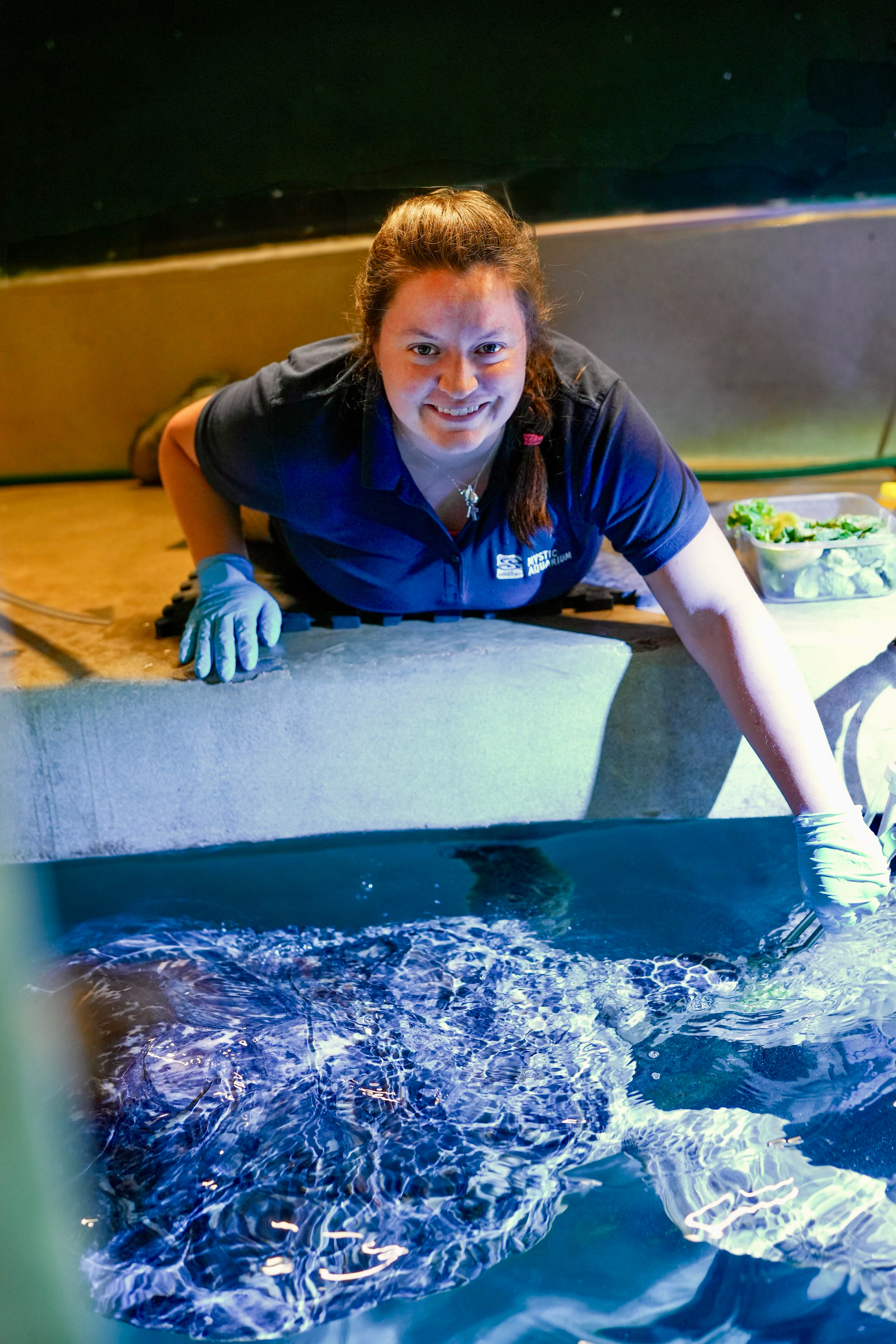
Currently a senior aquarist at Mystic Aquarium in Connecticut, Bolster has always been fascinated by marine ecosystems and wildlife. From her early experiences caring for injured birds and turtles at a wildlife rescue center on Georgia’s Jekyll Island to her work supporting the thousands of mammals, fish, invertebrates and reptiles at Mystic, Bolster is living a dream she’s had since she was a kid.
“As someone who has always wanted to be a marine biologist, this is pretty much my dream job,” Bolster said. “I love animals and getting to see their individual personalities, and I think it's really cool to be part of their lives. Being in a consistent working relationship with these animals has made my biggest dream come true, and I love getting to do it every single day.”
A childhood dream
Growing up in Towson, Maryland, Bolster’s favorite place to spend time was anywhere on or near the water.
“My parents are both lifelong sailors, so we grew up on the Chesapeake Bay sailing, and I loved being on the water,” Bolster recalled. “As a kid, I was always trying to find the random weird creatures around the bay, and I wanted to know more about them. So, by the time I was 8 or 9, I knew I wanted to be a marine biologist.”
Years later, that dream took Bolster to the University of Maryland, where she majored in biological sciences, specializing in ecology and evolution.
“I knew that there were environmental degrees, but I wanted the biology aspect because I found that really interesting,” Bolster said. “What excited me about the University of Maryland was that I could be an overarching biology major, but still study marine science, because I knew that was the career I wanted to go into.”
At UMD, Bolster was especially intrigued by her study of ecosystems, in the ocean and on land, and how they relate to each other.
“One of the things that I could take away from all of my classes is just how impactful and integrated each ecosystem is, how impacts from, say, soil science affect marine science, like the coastal and marine ecosystems,” she explained. “Each ecosystem is so unique to itself, but they're all so closely integrated that to understand one of them, you have to work with all of them. I found that fascinating.”
A summer internship at Baltimore’s National Aquarium before Bolster’s senior year gave her a glimpse of what her future in marine science might look like, and it was even better than she had imagined.
“That summer I got to follow two of the people who care for fish, invertebrates and reptiles and see what their daily work was like—and I loved it,” she recalled. “I always thought an aquarium would be a cool place to have my career and that confirmed it.”
A Science Terp on the turtle team
After graduation, Bolster headed to Jekyll Island, Georgia, completing national service for AmeriCorps at the Georgia Sea Turtle Center, a rehabilitation facility for shore birds, raptors, turtles and other aquatic wildlife. There, she worked with the veterinary team caring for injured and sick loggerheads, green and Kemp's ridley sea turtles, and—her favorite by far—terrapins.
“Jekyll Island is a hub for diamondback terrapins, which, for me, being a Maryland Terp, was fantastic,” she said. “We had animals that were in rehab as adults, and in the spring, we would have hundreds of eggs that we would care for from extraction to hatching and release. So, I got to see the entire first year of these terrapins' lives and then release them into the marsh, which was such a cool thing to be part of.”
Bolster did a brief stint on Assateague Island with the Maryland Conservation Corps before joining Mystic Aquarium as an aquarist in 2023. Since then, she’s handled the care and feeding of countless fish, invertebrates, reptiles and their habitats, getting a unique insight into each animal’s quirks and habits along the way.
“People tend to think of fish and sharks as not having personalities because they might not seem as charismatic as some of the mammals that they see, but we see a lot more,” Bolster explained. “There are consistent behaviors that we notice, like a certain puffer will come up to a specific area to eat, or one fish is notorious for trying to steal food from the others. We get to see the personalities of all of them.”
Learning from the animals
In the aquarium environment, the cast of characters and the conditions are always changing, and there’s always something new to learn.
“That's the other fun part—though I care for the same animals, every day is a little bit different,” Bolster noted. “One day we might be working on a stingray, another day we might be scuba diving in a habitat for a different animal. It’s always changing, and I love that.”
Recently promoted to senior aquarist, Bolster now works with several varieties of jellyfish and sharks, as well as one of Mystic’s most popular residents, an injured green sea turtle named Charlotte.
“Charlotte was hit by a boat when he was a juvenile, and the injury caused a slight shell deformity and injuries to his spine and GI system. This means that air can become trapped in his GI system and get stuck in his shell deformities, causing him to have positive buoyancy in his rear end, a syndrome in sea turtles known as ‘bubble butt syndrome.’ To assist Charlotte to have a more ‘regular’ swimming pattern, we were able to scan and then 3D-print a harness specifically for Charlotte's shell,” Bolster explained. “Now, I’m working with Charlotte to make sure that his harness is fitting, and as we're getting him more comfortable with the harness, we'll slowly add weight to help level him out and make him more comfortable.”
While Bolster continues her work with the animals at Mystic, she’s also working toward a master’s degree in fisheries and aquatic sciences at the University of Florida. Her undergraduate experience at UMD provides a strong foundation for every challenge she takes on.
“The groundwork biology that I was able to get from the University of Maryland classes, especially the ecosystem classes I took my senior year, definitely play a role because we have certain ecosystems that we try to replicate on a smaller scale in some of our habitats,” she explained. “Thanks to UMD, I have that understanding of biology that I wanted, and I'm applying that in the work I do here.”
And even after all her unique experiences and adventures, Bolster feels like her dream career in marine science is just getting started. Grateful for every learning experience along the way so far, Bolster looks forward to the adventures still to come.
“I pretty much always knew that I wanted to end up in the aquarium field, though I’m not sure this was the exact path I thought I would take,” she said. “Taking a slightly winding path to get here and being able to work at the different places that I did geared me up to be the most successful where I am now, and I’m grateful for every part of it.”



